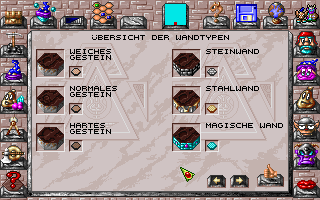Retro Replay Review
Gameplay
Magic of Endoria’s core gameplay loop revolves around exploration, resource management, and tactical combat, all unfolding in real time on a hexagonal map. As one of Endoria’s rival arch-mages, you dig twisting alleys into the underworld in search of the shattered crystal splinters left behind by the gods. Every tunnel you carve out or room you excavate requires careful planning—one wrong turn and you may leave your mine workers vulnerable to enemy skirmishes or environmental hazards.
(HEY YOU!! We hope you enjoy! We try not to run ads. So basically, this is a very expensive hobby running this site. Please consider joining us for updates, forums, and more. Network w/ us to make some cash or friends while retro gaming, and you can win some free retro games for posting. Okay, carry on 👍)
Your workforce is your most precious resource. Craftsmen forge new tools, researchers unlock advanced traps, hauliers transport ore to the surface, and warriors defend your halls. As these characters gain experience, their productivity and combat prowess improve, giving you a deep sense of progression. Juggling their salaries and skills creates a satisfying challenge, especially when enemy mages send mutated creatures or rival troops to contest your tunnels.
Issuing orders and setting routes is intuitive yet demands constant attention. You’ll spend much of your time on the hex grid, dragging waypoints to direct your workforce or clicking to dispatch reinforcements. The real-time aspect keeps the stakes high—there’s no pausing enemy advances, so you must remain vigilant, adapt to sudden threats, and continuously refine your underground network. For strategy fans who love multitasking and micromanagement, Magic of Endoria offers a deeply engaging playground.
Graphics
For its 1995 CD-ROM release, Magic of Endoria improved upon its Commodore 64 predecessor with richer color palettes and more detailed sprites. The underground corridors are rendered in moody shades of gray and blue, punctuated by the flicker of torchlight and the glow of crystalline splinters. Animations for digging and combat are modest by modern standards, but they convey essential information clearly—when a trap springs or a creature lunges, you see it.
The CD-ROM version also introduced new background music tracks that underscore the game’s dark fantasy atmosphere. Ambient cave echoes, the clang of pickaxes, and tense battle drums immerse you in the depths of Endoria. Small touches—like character portraits appearing during speech snippets—add personality to your miners and warriors, even though voiceovers are few and far between.
If you opt for the “light” version, the graphical complexity is pared down for smoother performance on lower-end PCs. While the visuals lose some polish, the core design remains intact, ensuring legibility during hectic skirmishes. The user interface strikes a good balance between information density and readability: resource bars, unit icons, and mini-map overlays give you a clear snapshot of your empire without undue clutter.
Story
The narrative premise of Magic of Endoria hinges on an ancient divine revolt. Disgusted by mortal cruelty, the gods shattered themselves into crystal splinters and retreated to the underworld. Whoever reclaims these splinters wields supreme power over the realm. This myth drives two rival arch-mages into a subterranean race, each determined to piece together godhood.
Story pacing is deliberately minimalist, reflecting the strategy-first design. You’ll encounter occasional cut-in dialogues when important research completes or critical battles erupt, but most of the lore emerges through in-game text and brief speech snippets. The online help feature provides extra context on deity myths, creature backstories, and unit types—helpful for players who want a deeper dive into Endoria’s legends.
Although the plot doesn’t evolve through elaborate cinematics, the stakes feel real as you stake claim on different crystal splinters. Rival arch-mages aren’t faceless foes; they send taunting messages, dispatch elite troops, and contest key resource nodes, keeping the competition personal. This intermittent narrative interplay lends every excavation and skirmish a sense of purpose and urgency.
Overall Experience
Magic of Endoria stands out as a complex, real-time strategy gem from the mid-’90s that still holds appeal for dedicated fans of resource management and tactical combat. Its mix of underground base building, worker progression, and hex-grid engagements offers substantial depth, though newcomers may face a steep learning curve. The “light” version eases complexity somewhat, making it a solid entry point.
Technical enhancements in the CD-ROM edition—voice snippets, richer music, and online help—elevate the immersion, though they don’t overshadow the game’s strategic heartbeat. Visually, the aesthetics are functional and atmospheric, and the UI supports rapid command issuing without overwhelming the player. Battles can scale up in variety as mutated creatures join the fray, ensuring that tunnel networks evolve into dynamic, ever-changing arenas.
For potential buyers seeking a retro strategy experience that balances base management, worker economy, and real-time tactics, Magic of Endoria is a rewarding challenge. Its emphasis on subterranean conquest and mythical lore gives it a distinct flavor. While it demands time and focus, the satisfaction of unearthing crystal splinters and outsmarting a rival arch-mage makes the journey into Endoria’s depths thoroughly worthwhile.
 Retro Replay Retro Replay gaming reviews, news, emulation, geek stuff and more!
Retro Replay Retro Replay gaming reviews, news, emulation, geek stuff and more!









Reviews
There are no reviews yet.